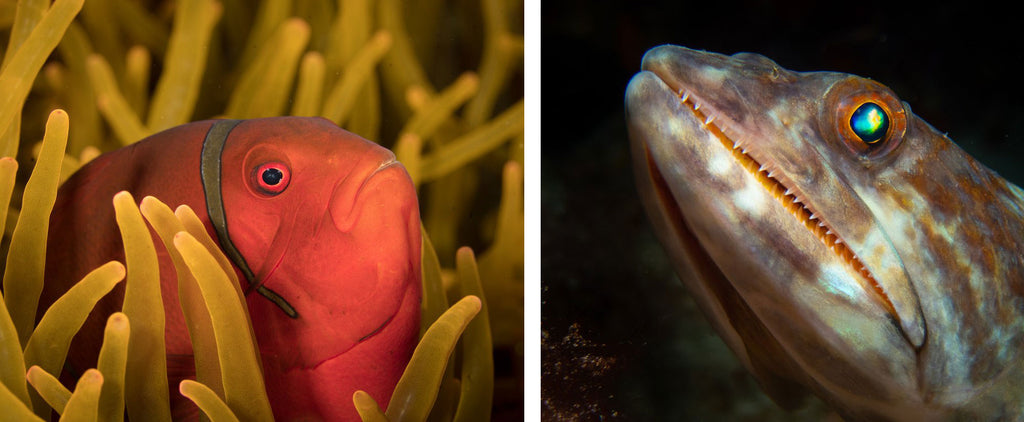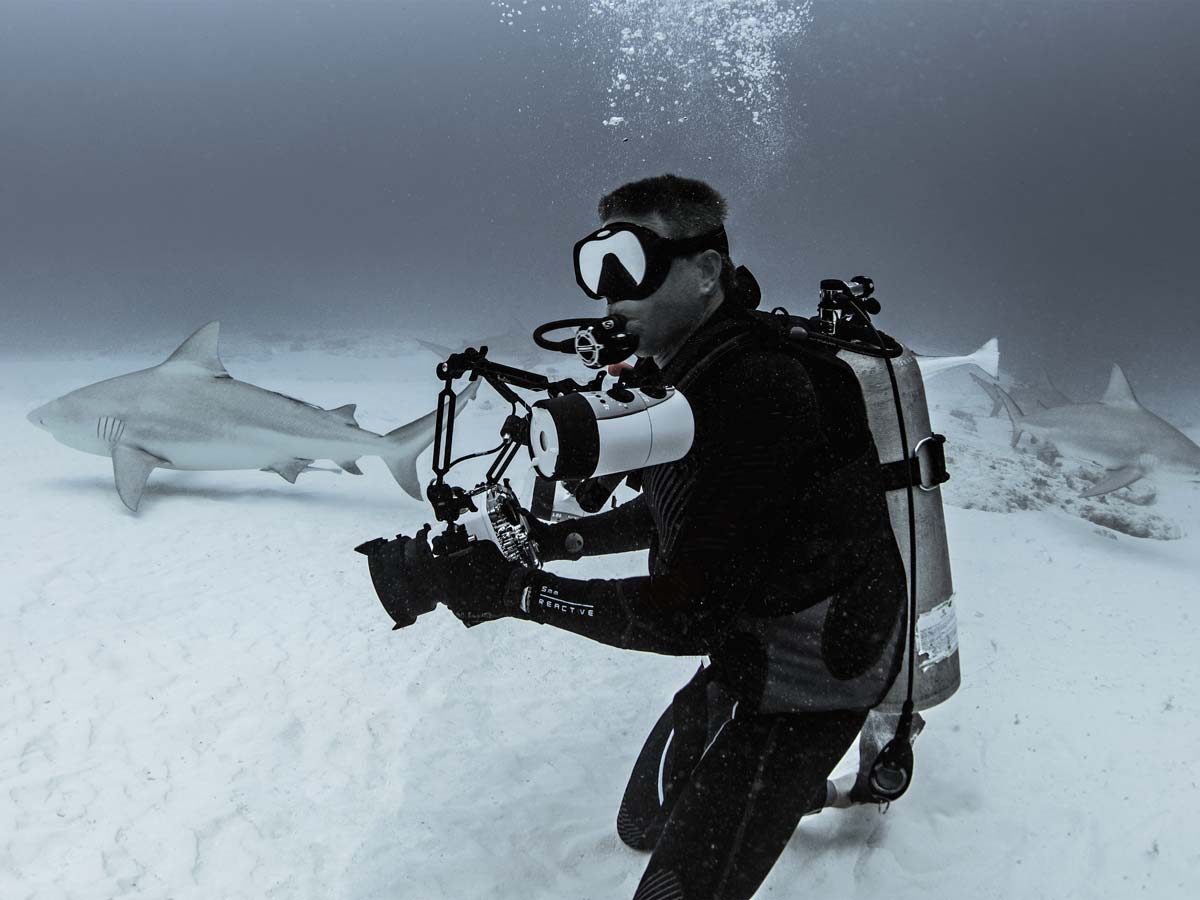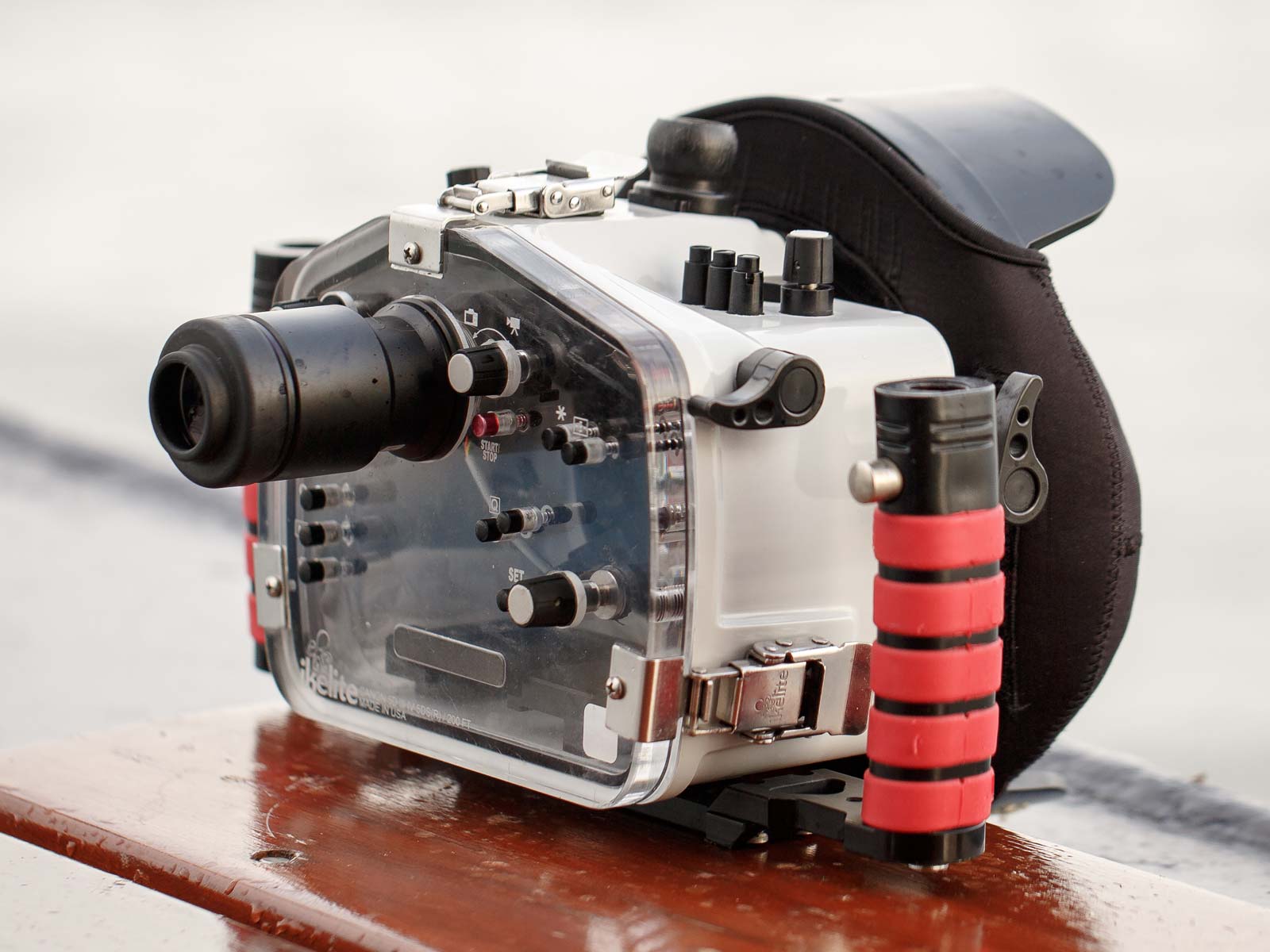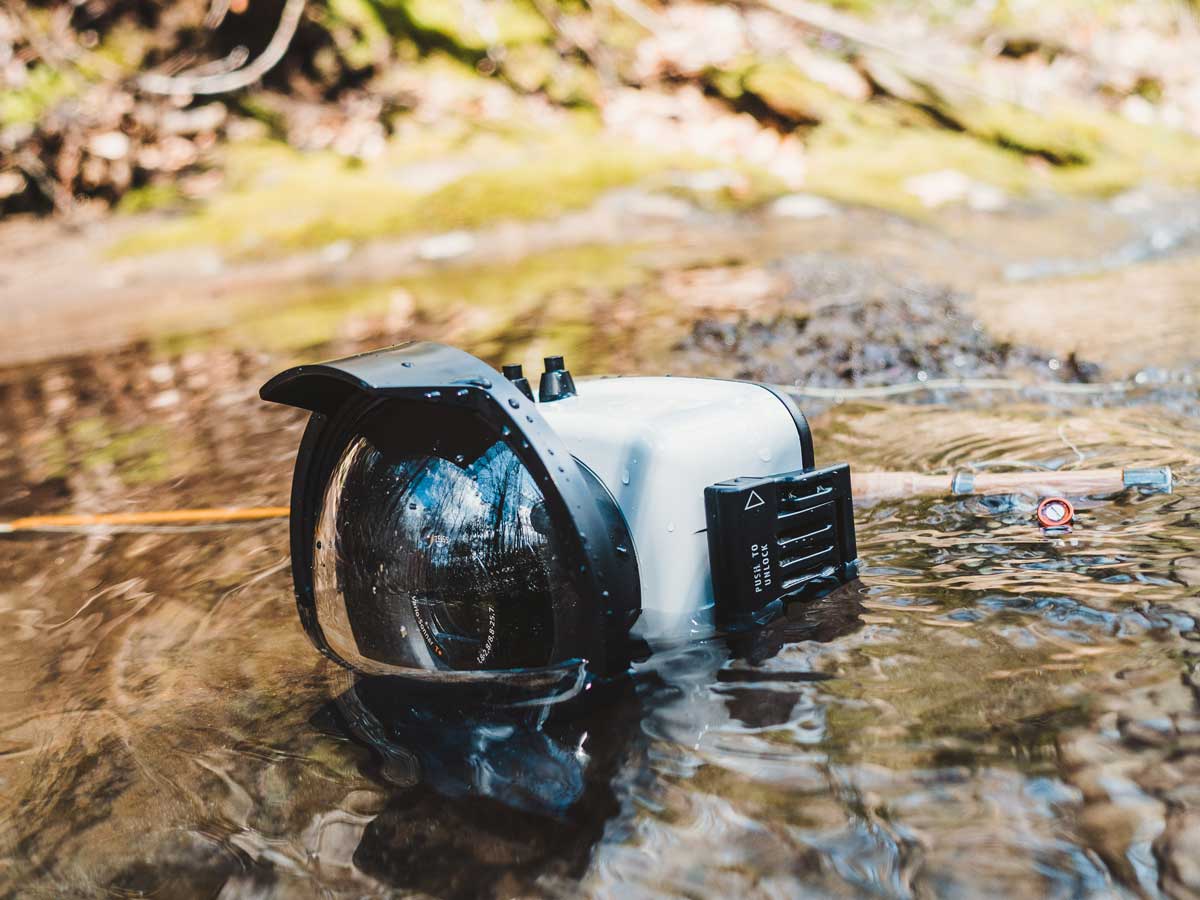There are a lot of myths floating around about TTL use underwater and why to use it or not. We breakdown the science of TTL to explain how it can help you leverage a powerful photographic tool underwater.
What is TTL
Thru-the-lens (TTL) metering means that the camera evaluates the scene and adjusts flash power to properly expose the subject. In digital cameras, this is accomplished through a series of pre-flashes where the camera asks the strobe to fire one or more very short flashes and then uses that data to set a flash duration for the final shot.
Have you ever used a camera's built-in flash, or attached a camera manufacturer's flash to the top of your camera? Then you're already familiar with TTL flash exposure. You set the camera, the camera sets the strobe.
Shooting in Manual
You may have already been told by a more experienced underwater photographer that you always want to shoot manual. Actually this is true- you usually want your camera to be in a manual shooting mode (M) if possible. In manual mode, you set the aperture and shutter speed of your camera.
However, your strobe exposure mode is different from your camera exposure mode. "Automatic" TTL flash does not mean the camera's shooting mode is set to Auto. With most cameras, it is possible to have the best of both worlds and use a manual shooting mode on your camera and a TTL exposure mode on your strobe. You adjust the camera settings (aperture and shutter speed) manually and the camera adjusts the flash duration automatically (TTL).

Manual shooting mode on the camera does not mean the same thing as manual exposure mode for your flash or strobes.
The most notable exceptions are the older Canon G-series cameras like the G16, which only provide TTL strobe operation in automatic camera modes like Aperture priority (Av) or Shutter priority (Tv).
Keep in mind that automatic camera modes, particularly priority modes, can be useful in some underwater shooting environments. Shallow water wide angle with larger subjects like dolphins or manatees and cavern diving are good examples. Whenever available light or depth is varying rapidly then your camera’s automatic modes may be your friends.
Of course there are creative lighting scenarios where you want to achieve side or back lighting, or maybe darker areas to create a mood. Often this is just a matter of repositioning your strobes forwards or backwards, perhaps at different distances from your subject. Manual strobe exposure is always an option, but situations where it will actually improve a photo are more rare.

Careful adjustments to your strobe arms (usually out to the sides) will allow you to create shadows of varying brightness. Imagine this scene drenched in light with no shadows; it would likely be pretty, but not deep. Shadows add depth and dimension to a flat image.
TTL for Macro photography
Macro close-up photography is the classic application of TTL strobe performance. Even a small slave TTL strobe can bring out beautiful colors in a macro subject. Your camera must be able to attain focus and metering for good results, which may require use of a focus or aiming light.
The basics for great macro are relatively easy: get close to your subject, shoot at a smaller aperture (higher f/number), point your strobes correctly, and try to focus on the eye of your subject.

Macro is a no-brainer application of TTL strobe exposure. The photo on the left was taken with the DL2 DS Link Sony TTL Converter. The photo on the right was taken with the RC1 Olympus TTL Receiver.
TTL for Wide Angle photography
One of the most famous myths about TTL is that it doesn’t work for wide angle photography. This couldn’t be further from the truth.
When shooting wide angle, meter on the background and set your camera’s exposure accordingly. Keep the strobes in TTL and they will do all of the work properly exposing anything within about 3-6’ (1-2m) from the fronts of the strobes.

Examples of wide angle photography with TTL flash taken using the DL2 DS Link Sony TTL Converter with dual DS161 strobes.
Types of TTL
Electrical TTL transmission is when there is a direct wired connection between the camera and the strobe. Electrical TTL requires special circuitry either built into the housing or into a separate converter. This circuitry is programmed to trick the camera into thinking one of its proprietary flashes are attached; for example, a Nikon camera would think that you have connected a Nikon Speedlight and it would know exactly what to do with that information. Generally this overrides the camera’s built-in flash and gives preference to the strobe. The camera’s flash doesn’t need to fire and the camera sends a high-speed electronic signal to the strobe to trigger and quench. Examples of electrical TTL systems are the DL1 Nikon TTL Converter and the 200DLM/C Underwater TTL Housing for the Canon Rebel SL2.
Wireless TTL is a special mode available on only select higher-end cameras. Nikon calls it CLS mode, Olympus calls it RC flash mode, and so on. When using this flash mode, the camera knows that external strobes are present. The camera uses its own flash to transmit pulse codes telling the off-camera strobes when and how much to fire. Wireless TTL is not to be confused with cordless. Underwater a fiber optic cord is usually desirable to transmit the camera's signal more efficiently. An example of wireless TTL function is the RC1 Olympus & Panasonic TTL Receiver for DS Strobes.
Slave TTL (sometimes called S-TTL) function is when an external strobe watches the camera’s flash and attempts to mimic its output. The camera does not know that an external strobe is being used and does not directly tell the external strobe how much or when to flash. The strobe is making its own decisions based on what it sees the camera’s flash doing. The strobe may be connected by fiber optic cord like with many INON or SEA&SEA strobes, or may be watching through a sensor as with our old AF35 strobe.
Slave TTL protocols are built into the strobe which mean they need to be generic. The TTL is not fine-tuned to any particular camera make or model, which can be a major detriment to accuracy.

There are three major types of TTL strobe receivers (from left to right): Wireless, Electrical, and Slave. Both Wireless and Slave TTL can be with or without fiber optic cable.
If your strobes are close enough to the camera to be connected by sync cord, electrical TTL is the gold standard for fast, reliable, and accurate TTL exposure. Here are the major benefits of electrical TTL strobe exposure:
#1 Electrical TTL provides critical speed
There are several ways that TTL works for you to enhance your system’s rapid firing capabilities. The most obvious way is that it’s adjusting your strobe power, which means you don’t have to. To shoot with manual strobe exposure, you need to physically reach up and rotate the switches on each of your strobes to the desired power setting. You need do this every time your distance to subject changes. With fast moving subjects like turtles and sharks this may be impossible to do.

This turtle was approaching too fast to re-adjust two strobes manually. Without TTL exposure, the last (best) photo would have been totally blown out by an overpowered strobe.
#2 Electrical TTL improves camera battery life and reduces heat inside of the housing
Both wireless and slave TTL systems require the camera's flash to fire on every shot. This dramatically reduces camera battery life, which can already be an issue when writing large RAW files. The camera's built-in flash also generates a lot of heat that can lead to fogging and further degrades battery performance. The camera’s flash does not fire with electrical TTL so these are non-issues.
#3 Electrical TTL provides more variety in flash duration
Electrical TTL also dramatically expands the availability of fractional power settings—i.e. shorter flash durations—for your strobe. Your strobe may have 10-12 manual fractional powers. TTL provides dozens or even hundreds of possible strobe timings. This allows your strobes to recycle more quickly for less time in between photos. It also helps you take more photos on each charge because generally each flash is some fraction shorter than it would be in a manual setting. And best of all it makes it more accurate because it is not limited to +/- half or one-third f/stop intervals.
#3 Dual strobe performance is better with electrical TTL
Fiber optic transmitters are notorious for intermittent operation with two strobes. Each fiber optic window may not transmit the exact same amount of light, meaning that your strobes will be receiving slightly different signals. Electrical cables transmit the same signal to both strobes at the same time for the most precise and repeatable dual strobe performance.
#4 Electrical TTL improves the accuracy of the camera’s signal
For the most accurate strobe exposure, the camera must know that a strobe is being used. Only electrical and wireless methods make this possible. When the camera knows that the strobes exist, it understands that it is not limited to the function of its own built-in flash. It controls the preflash durations of the strobes and reads the feedback accordingly. With slave TTL systems, the camera is “firing blind”—it’s firing its own flash but only seeing the more powerful strobes. This can cause it to under-expose on the final image.
#5 Electrical TTL is more reliable than optical TTL
Any cord—electrical or fiber optic—will cause unreliable triggering if damaged by bending, cutting, or flooding. Electrical TTL cables eliminate the problem of false triggering that are common in both optical and fiber optic based transmission methods.
Electrical TTL strobe operation also provides the longest camera and strobe battery life of all strobe exposure methods. If you’ve ever seen something amazing at the tail end of the second or third dive of the day then you know how important this can be. You want to confidently leave your camera on until the end of your last dive, and know that your strobes will fire when you pull the trigger. Electrical TTL is still the best insurance for this scenario.

TTL can even work on highly reflective subjects underwater, which can be one of the most challenging lighting scenarios.
Conclusion
Perhaps the most confounding myth is that TTL does not work underwater. We’re not sure who invented this tall tale, but we can guarantee you that it isn’t true. TTL strobe exposure worked back in the days of film, and it definitely works in the days of digital.
There are a lot of challenges you’re facing when when you’re shooting underwater- making sure your life support gear is working, maintaining good buoyancy and control, trying to catch your subject at just the right time, maybe even staying aware of where your dive buddy is. In 98% of shooting scenarios you can use TTL to leave the flash exposure up to the camera and know you’re in good hands.
Additional Reading
Choosing Strobes for Ikelite TTL Systems













